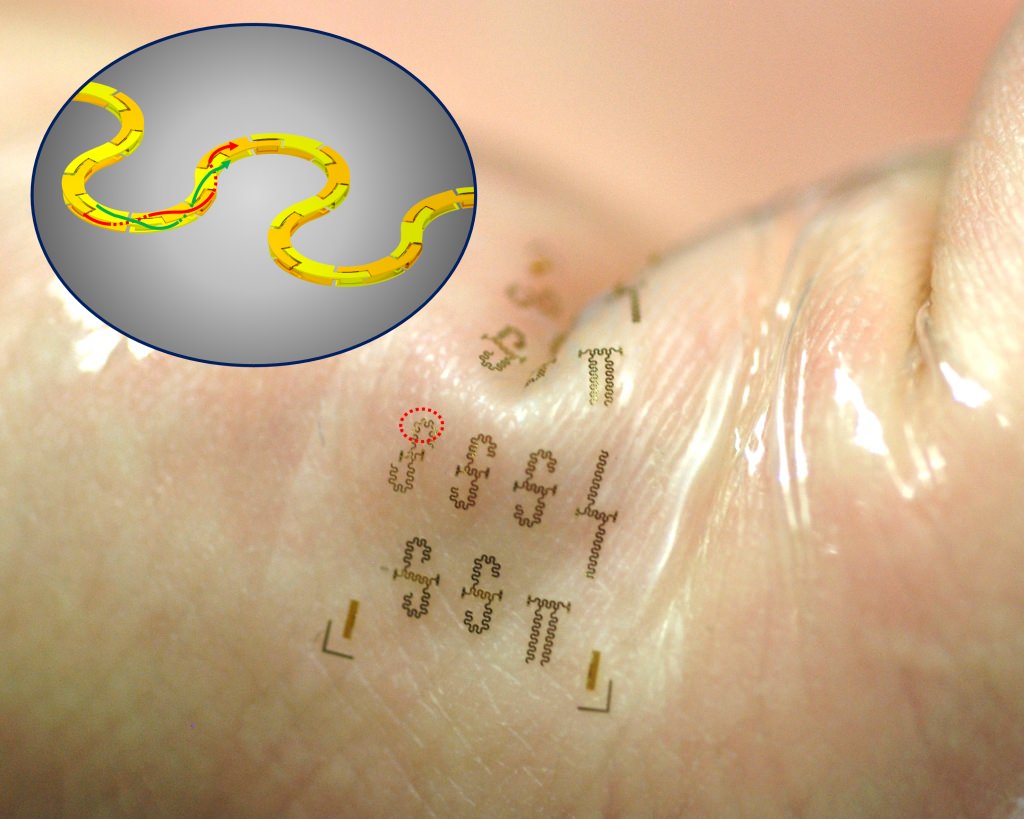
Fabricated in interlocking segments like a 3-D puzzle, the new integrated circuits could be used in wearable electronics that adhere to the skin like temporary tattoos. Because the circuits increase wireless speed, these systems could allow health care staff to monitor patients remotely, without the use of cables and cords. IMAGE COURTESY OF YEI HWAN JUNG AND JUHWAN LEE
The consumer marketplace is flooded with a lively assortment of smart wearable electronics that do everything from monitor vital signs, fitness or sun exposure to play music, charge other electronics or even purify the air around you—all wirelessly. Now, a team of University of Wisconsin-Madison engineers has created the world’s fastest stretchable, wearable integrated circuits, an advance that could drive the Internet of Things and a much more connected, high-speed wireless world.
The advance is a platform for manufacturers seeking to expand applications of wearable electronics—including those with biomedical applications—especially to develop devices that take advantage of new generation of wireless broadband technologies ie 5G. With wavelength sizes between a millimeter and a meter, microwave radio frequencies are electromagnetic waves that use frequencies in 0.3 – 300GHz range ie 5G range. In mobile communications, the wide microwave radio frequencies of 5G networks will accommodate a growing number of cellphone users and notable increases in data speeds and coverage areas.
In ICU, epidermal electronic systems (electronics that adhere to the skin like temporary tattoos) could allow health care staff to monitor patients remotely and wirelessly, increasing patient comfort by decreasing the customary tangle of cables and wires.
What makes the new, stretchable integrated circuits so powerful is their unique structure, inspired by twisted-pair telephone cables. They have 2 ultra-tiny intertwining power transmission lines in repeating S-curves. This serpentine shape—formed in 2 layers with segmented metal blocks, like a 3D puzzle—gives the transmission lines the ability to stretch without affecting their performance. It also helps shield the lines from outside interference and, at the same time, confine the electromagnetic waves flowing through them, almost completely eliminating current loss. Currently, the stretchable integrated circuits can operate at radio frequency levels up to 40GHz.
And, unlike other stretchable transmission lines, whose widths can approach 640 micrometers the new stretchable integrated circuits are just 25 micrometers thick. That’s tiny enough to be highly effective in epidermal electronic systems, among many other applications.
Ma’s group has been developing what are known as transistor active devices for the past decade. This latest advance marries the researchers’ expertise in both high-frequency and flexible electronics. “We’ve found a way to integrate high-frequency active transistors into a useful circuit that can be wireless,” says Ma. “This is a platform. This opens the door to lots of new capabilities.”
http://news.wisc.edu/fast-stretchy-circuits-could-yield-new-wave-of-wearable-electronics/







Recent Comments